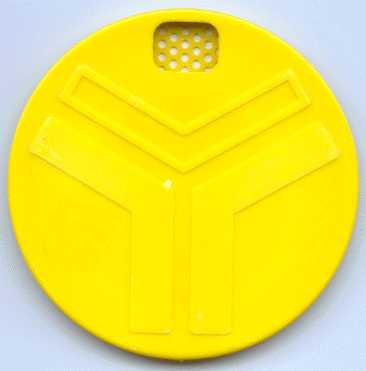|
|
|
|---|
Swienty Round Bee Escape
|
|---|
|
I have seen this item in the Swienty 1999 catalogue. The picture at right is of the undersurface and has been provided by Bjørn Andresen, to whom I am also endebted for the picture of the top surface that occurs below this text. It is 119 mm in diameter and 10 mm thick, with a tapered annular track that the bees run around in two streams from the entrance hole in the top to two, almost square, exit holes in the bottom. The larger rectangular entrance opening has a perforated area in the opposite face. |

|
|---|

|
The arrangement of two escapes in the same board. as in the small illustration at right, is similar to one I found in an old Thomas catalogue. I am not so sure that this is as useful as when porter escapes are used, I think the yellow ones can clear a larger number of bees per minute and are less likely to become blocked by bees. |
|---|
|
Since originally writing this page I have found a similar item that I think has come from somewhere in eastern Europe. (I will attempt to find out where and update this page.) It is vacuum formed in thin white plastic and is designed to fit the same circular recess that the yellow one above fits. It is different in that the two paths are not joined at the exit and the exit holes are round instead of square, but it works in an identical fashion. |

|
|---|
|
Another version has come to light that is believed to be manufactured in Italy (the one in the photographs at right was supplied to a beekeeper in Italy). It is yellow and of the same size, but appears to have been made by injection moulding. The photographs were supplied by Huw Evans. This escape looks superficially the same as the Swienty one, but as you can see from small insets, there is a shrinkage line between the two exits caused by the dividing web between them, This divider effectively blocks the circular path within the escape, which in turn stops bees from travelling all the way round and back to the entrance. The risk of bees circulating around the loop inside the escape is higher than you might think, see... this experiment. |


|
|---|
Written... 20 April 2001, Revised... 05 April 2002, Upgraded... 20 September 2005, Addition... 15 July 2007, Revised... 04 August 2008,
|